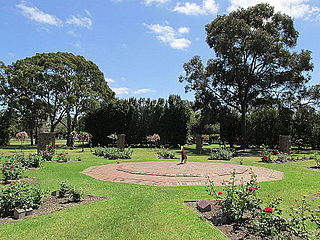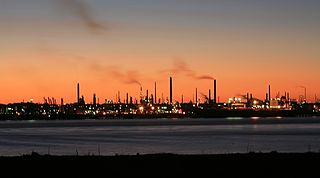Mobil is a petroleum brand owned and operated by American oil and gas corporation ExxonMobil. The brand was formerly owned and operated by an oil and gas corporation of the same name, which itself merged with Exxon to form ExxonMobil in 1999.

Altona North is a suburb in Melbourne, Victoria, Australia, 10 km (6.2 mi) south-west of Melbourne's Central Business District, located within the City of Hobsons Bay local government area. Altona North recorded a population of 12,962 at the 2021 census.
The oil and gas industry is usually divided into three major sectors: upstream, midstream, and downstream. The downstream sector is the refining of petroleum crude oil and the processing and purifying of raw natural gas, as well as the marketing and distribution of products derived from crude oil and natural gas. The downstream sector reaches consumers through products such as gasoline or petrol, kerosene, jet fuel, diesel oil, heating oil, fuel oils, lubricants, waxes, asphalt, natural gas, and liquefied petroleum gas (LPG) as well as naphtha and hundreds of petrochemicals.

Hindustan Petroleum Corporation Limited (HPCL) is an Indian public sector undertaking in petroleum and natural gas industry, headquartered in Mumbai, and a subsidiary of the Oil and Natural Gas Corporation (ONGC), which is owned by the Ministry of Petroleum and Natural Gas, Government of India.

Petron Corporation is the largest oil refining and marketing company in the Philippines, supplying more than a third of the country's oil requirements. It operates a refinery in Limay, Bataan with a rated capacity of 180,000 barrels per day (29,000 m3/d). From the refinery, Petron moves its products mainly by sea to 32 depots and terminals throughout the country.

Coryton Refinery was an oil refinery in Essex, England, on the estuary of the River Thames 28 miles (45 km) from central London, between Shell Haven Creek and Hole Haven Creek, which separates Canvey Island from the mainland.

Marsden Point Oil Refinery was a 96,000 BPD refinery located at Marsden Point, Whangarei, Northland, New Zealand. It was the only oil refinery in New Zealand, and is operated by Refining NZ. The point was named after Samuel Marsden. The regional survey map shows it was called Marsden Point in 1907.

Fawley Refinery is an oil refinery located at Fawley, Hampshire, England. The refinery is owned by Esso Petroleum Company Limited, a subsidiary of Exxon Mobil Corporation, which acquired the site in 1925. Situated on Southampton Water, it was rebuilt and extended in 1951 and is now the largest oil refinery in the United Kingdom, and one of the most complex refineries in Europe. With a capacity of 270,000 barrels (43,000 m3) per day, Fawley provides 20 per cent of the UK's refinery capacity. Over 2,500 people are employed at the site.
Gdańsk oil refinery is a 10.5 million tonne per year refinery located near the Polish city of Gdańsk on the Baltic Sea. The refinery was established in 1975 to supply fuels and lubricants, and has undergone several upgrades and expansions to increase its capacity and the range of products available. It now has a Nelson complexity index of 11.1. It is one of two oil refineries in Poland, the other is Plock refinery.

Grangemouth Refinery is an oil refinery complex located on the Firth of Forth in Grangemouth, Scotland, currently operated by Petroineos.
The Esso Refinery at Milford Haven was an oil refinery situated on the Pembrokeshire coast in Wales. Construction started in 1957 and the refinery was opened in 1960 by the Duke of Edinburgh. Construction cost £18 million and the refinery had the initial capacity to process 4.5 million tons of crude oil a year.

The Clyde Refinery was a crude oil refinery located in Clyde, New South Wales, Australia, operating between 1925 and 2013. At the time of its closure it had a refinery capacity of 85,000 barrels per day (13,500 m3/d) and was the oldest operating oil refinery in Australia. It was operated by Shell Refining (Australia) Pty Ltd and owned by the Royal Dutch Shell.

Petroleum refining processes are the chemical engineering processes and other facilities used in petroleum refineries to transform crude oil into useful products such as liquefied petroleum gas (LPG), gasoline or petrol, kerosene, jet fuel, diesel oil and fuel oils.

Ceylon Petroleum Corporation, commonly known as CEYPETCO (CPC), is a Sri Lankan oil and gas company. Established in 1962 and wholly owned by the Government of Sri Lanka, it is largest oil company in the Sri Lanka. It was formed in 1961 by nationalisation and expropriation of all private oil companies in Sri Lanka at the time of its formation. It is under the ownership of Ministry of Petroleum Resources Development headquartered in Colombo. It is the largest government owned company in the country, with an operational profit of Rs. 33.9 billion for the financial year 2020.

Kwinana Oil Refinery was sited on the shore of Cockburn Sound at Kwinana, near Fremantle, Western Australia. Built by the Anglo-Iranian Oil Company and completed in 1955, it was the largest oil refinery in Australia, with a capacity of 138,000 barrels per day (21,900 m3/d). It was closed by BP in March 2021 to be converted to an import-only terminal.

Puma Energy is a Swiss multinational mid- and downstream oil company, majority-owned by Singapore-based French company Trafigura.
Cnergyico Pk Limited is a Pakistani petroleum company which is a subsidiary of the Mauritian company Cnergyico Industries Incorporated. The company is vertically integrated across the oil refining and marketing industries, notable for being the only petroleum company in Pakistan to own and operate a crude oil terminal. Cnergyico operates Pakistan’s biggest oil refinery in terms of nameplate capacity, the largest capacity crude oil storage tanks in the country, and a network of petrol pumps.

Petroleum refining in the United States in 2013 produced 18.9 million barrels per day of refined petroleum products, more than any other country. Although the US was the world's largest net importer of refined petroleum products as recently as 2008, the US became a net exporter in 2010, and in 2014 was the largest exporter and the largest net exporter of refined petroleum. As of January 2019, there were 135 operating refineries in the US, distributed among 30 states.
The Dangote Refinery is an oil refinery owned by Dangote Group that was inaugurated on the 22nd of May 2023 in Lekki, Nigeria. When in full operation, it is expected to have the capacity to process about 650,000 barrels per day of crude oil, making it the largest single-train refinery in the world. The investment is over 19 billion US dollars.
Australia is a major petroleum producer and importer, with a number of petroleum companies involved in upstream and downstream operations. Western Australia is the largest contributor to Australia's production of most petroleum products.













